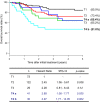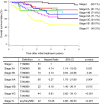Characteristics of anal canal cancer in Japan
- PMID: 35274487
- PMCID: PMC9302302
- DOI: 10.1002/cam4.4631
Characteristics of anal canal cancer in Japan
Abstract
Anal canal cancer (ACC) has been reported to be an uncommon cancer in Japan, as in the USA, Europe, and Australia. This retrospective multi-institutional study was conducted to clarify the characteristics of ACC in Japan. First, the histological ACC type cases treated between 1991 and 2015 were collected. A detailed analysis of the characteristics of anal canal squamous cell carcinoma (SCC) cases was then conducted. The results of the histological types revealed that of the 1781 ACC cases, 435 cases (24.4%) including seven cases of adenosquamous cell carcinomas were SCC and 1260 cases (70.7%) were adenocarcinoma. However, the most common histological type reported in the USA, Europe, and Australia is SCC. Most ACC cases are adenocarcinomas and there is a low incidence of SCC in Japan which is different from the above-mentioned countries. Moreover, we reclassified T4 into the following two groups based on tumor size: T4a (tumor diameter of 5 cm or less) and T4b (tumor diameter of more than 5 cm). The results of the TNM classification of SCC revealed that the hazard ratio (HR) to T1 of T2, T3, T4a, and T4b was 2.45, 2.28, 2.89, and 4.97, respectively. As T4b cases had a worse prognosis than T4a cases, we propose that T4 for anal canal SCC in Japan be subclassified into T4a and T4b.
Keywords: abdominoperineal resection; anal canal cancer; chemoradiotherapy; human papillomavirus; squamous cell carcinoma.
© 2022 The Authors. Cancer Medicine published by John Wiley & Sons Ltd.
Conflict of interest statement
Kazutaka Yamada and the co‐authors have no conflicts of interest to declare.
Figures



References
-
- Clark MA, Hartley A, Geh JI. Cancer of the anal canal. Lancet Oncol. 2004;5:149‐157. - PubMed
-
- International Agency for Research on Cancer. Global Cancer Observatory Cancer today. https://gco.iarc.fr/today/fact‐sheets‐populations. Accessed December 3, 2021.
-
- Anal canal and perianal skin. In: Brierley JD, Gospodarowicz MK, Wittekind C, eds. TNM Classification of Malignant Tumours, 8th ed (UICC). Wiley Blackwell, 2017. 77–79.
-
- Welton ML, Steele SR, Goodman KA, et al. Anus. In: Amin MB, ed. AJCC Cancer Staging Manual. 8th ed. Springer; 2017:275‐284.
-
- Klas JV, Rothenberger DA, Wong WD, Madoff RD. Malignant tumors of the anal canal: the spectrum of disease, treatment, and outcomes. Cancer. 1999;85:1686‐1693. - PubMed
Publication types
MeSH terms
Supplementary concepts
LinkOut - more resources
Full Text Sources
Medical
Research Materials

